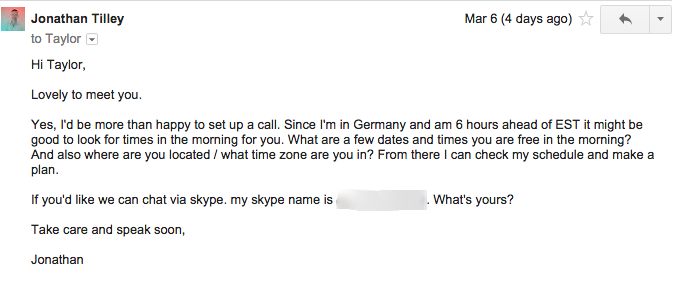Last week my partner Tara received an email introduction that went downhill fast. She was a victim of a classic awkward email situation: an e-introduction without a clear purpose.
I’m not one to point fingers. I’ve made plenty of good and bad introductions in my day. I’ve learned that the difference between the two is like the difference between fine art and a forgery. One is exquisite and invaluable; the other will make people angry and land you in networking jail, a dark place where your relationships are worthless.
By no means have I mastered the art of introductions but having recently been called a “super-connector” I think I can safely say that a few simple adjustments can turn painful, burdensome introductions into great value.
When You’re the One Making an Introduction
1. The Two-Sided Opt-in: Always Confirm with Both Parties
When you make an unwanted introduction, you’re asking me to take care of a living, breathing creature with feelings. Don’t put that on me.
When I make an introduction, I always pitch it to both parties separately first. I use the word “pitch” intentionally: an introduction is an offer of value, and you want to portray it as such. If the person accepts your offer and converts that contact into value, you earn some relationship equity. If you’re going to bother suggesting the introduction, you may as well make it as appetizing as possible.
The other benefit of the two-sided opt-in is that you dramatically increase the chances that the connection will be consummated. Having already said “yes” to your initial outreach, both parties are more likely to reply promptly and perceive the introduction as valuable. This is due to the principle of consistency, whereby we behave consistently with past actions to avoid cognitive dissonance. In other words, the two-sided opt-in increases the odds that your effort bears fruit.
I’ve found that the best way to set up a two-sided opt-in is to be transparent: I always let people know that I’m going to check with the other person first. Letting everyone know that you’re checking first sends the signal that you respect everyone’s time. Should one person decline the introduction you can also prevent any loss of face.
Here’s a script you can use if one person never replies:
“Hey, I haven’t heard back yet. I know person A is super busy, I’ll follow up again and let you know if I hear back.”
An outright decline rarely happens but if it does you have an opportunity to absorb the blow before passing it along (if you need to at all).
No harm, no foul.
2. Do the Work to Bridge the Gap
One of my pet peeves is getting an introduction when I have no idea what’s in it for me (WIIFM). Sure, I could dig around and get something valuable from the introduction. I could also grab a shovel and dig for gold in my backyard, but I’m not going to bother unless I know it’s there.
Before you propose an introduction have a clear idea of what gap you’re bridging. That way when you reach out to each person you’re essentially saying: “I can build this bridge for you, but before I do, would you tell me if this is a bridge you’d like to cross?”
Keep in mind that what constitutes a bridge can only be determined by its beneficiaries.
If you’re looking to meet like-minded singles in your area then common vocation, interests and geography might result in a meaningful date. If you’re trying to find clients, those same attributes might mean that someone is a competing service provider — an introduction you may not want.
If you aren’t clear about the bridge, you’re not ready to write an introduction.
When You’re the One Receiving an Introduction
3. Don’t Be Afraid to Graciously Excuse Yourself
Just because someone reaches out to you to set up a phone call or coffee date doesn’t mean that you have to do it. If someone stuck their foot in the door of your home, would you invite them in just because the door’s already open? No. Treat your time as your home and only allow people in when they’ve earned it. But if you’re going to say no, do it with class.
Occasionally I get an email from someone to set up a call where they offer me just a one-time slot. Subtext: “If that time doesn’t work for you, too bad.” Then there’s the presumptive implied request: “I can be reached at (xxx) xxx-xxxx.” Subtext: “Come and get me.” Both of these behaviours send a not-so-subtle message: “You’re not important.”
Email invites us to be douchebags. It’s so impersonal. So easy to cut corners. And lots of people do. That doesn’t make it the right, or wise. An email is a conversation with a human being. Terse, aloof and dismissive email is rude, passive-aggressive and cowardly. If you don’t see value in a conversation, end it graciously.
For a great example of how to excuse yourself, check out this elegant message Tara used to diffuse the awkward email situation I mentioned earlier:
4. If You’re a Yes, Act Like It
If you actually care about the person on the other end of the conversation, be polite and thorough.
Last week I received a reply to an email introduction that was so gracious that I told my fiancee about it and saved a screenshot.
Jonathan Tilley is a business development expert for artists and freelancers and he clearly walks the talk.
As you can see, he takes the time to signal his investment in our future relationship. He connects. He answers my question directly. He is “more than” happy to talk. He co-creates an agreement about how to do so with zero presumption. He signs his entire name.
5. Provide Feedback to Your People
You can be a force for good in the email universe (and your own inbox) by training your people how to act.
When you get a dubious introduction, write back privately. Thank the person for thinking of you. Then ask if they had a specific opportunity in mind when they wrote it.
Your intention should be to express gratitude and draw out any potential value in the connection. The subtext will be understood.
Now, go forth and make it rain valuable connections.


































